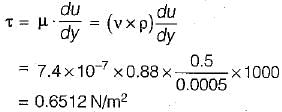Test: Viscous Flow - 3 - Mechanical Engineering MCQ
10 Questions MCQ Test - Test: Viscous Flow - 3
For laminar flow in pipes the momentum correction factor is
For turbulent flow in pipes the momentum correction factor is
| 1 Crore+ students have signed up on EduRev. Have you? Download the App |
For laminar flow is pipe, the kinetic energy correction factor is
Which one of the following is correct for the velocity distribution across a section of two fixed parallel plates having viscous flow, where t is the distance of parallel plate
What would be the shear stress distribution across a section of two fixed parallel plates kept at a distance t apart and having a viscous flow
An incompressible fluid (kinematic viscosity, 7.4 x 10-7 m2/s, specific gravity, 0.88) is held between two parallel plates. If the top plate is moved with a velocity of 0.5 m/s while the bottom one is held stationary, the fluid attains a linear velocity profile in the gap of 0.5 mm between these plates; the shear stress in Pascals on the surface of top plate is
The maximum velocity of a one-dimensional incompressible fully developed viscous flow, between two fixed parallel plates, is 6 ms-1. The mean velocity (in ms-1) of the flow is
The shear stress developed in a lubricant oil viscosity 9.81 poise, filled between two parallel plates 1 cm apart and moving with relative velocity of 2 m/sec is
The drag coefficient for laminar flow varies with reynolds number (Re) as
The transition Reynolds number for flow over a flat plate is 5 x 105. What is the distance from the leading edge at which transition will occur for flow of water with a uniform velocity of 1 m/s (for water the kinematic viscosity v = 0.86 x 10-6m2/s)






















